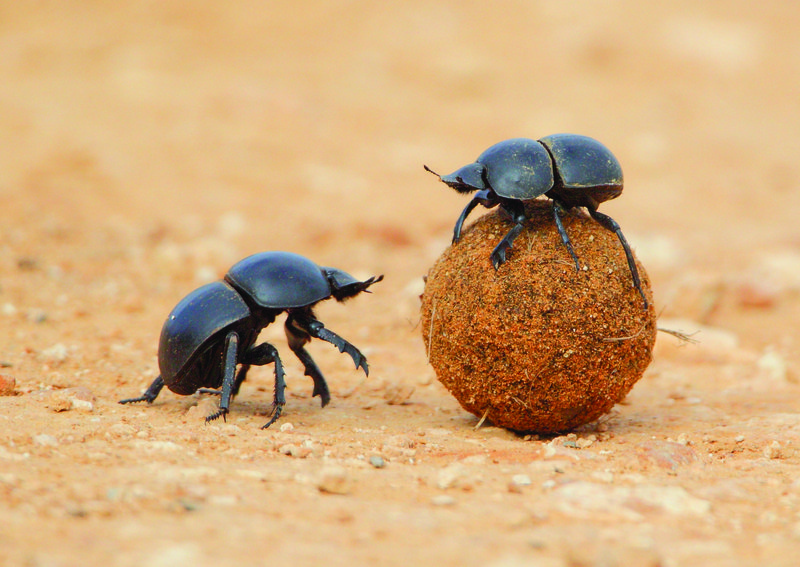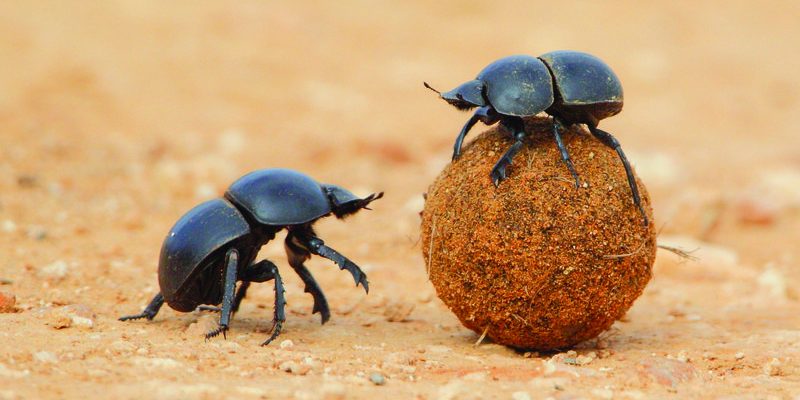
At first glance, it might seem like dung beetles are simply working hard, but their lives are full of interactions that involve a mix of instinct, chemical signals, and even a bit of drama. Communication for them involves more than just rolling dung; it’s about survival, mating, and establishing territory. Let’s dive into the world of dung beetles and explore how they connect with each other and their environment.
Understanding Dung Beetles’ Social Structure
Dung beetles often stick to their own species, which might remind you of how some people have their go-to friends. They form small communities that share food sources—like dung, which is their primary meal. Now, this part is crucial: each species has unique pheromones or chemical signals that they use to identify each other. When a dung beetle encounters another, it can often tell if it’s a friend or foe just by the smell, which is like having a superpower for scent recognition.
In addition to chemical signals, dung beetles also have visual signals. They often use their colors and body postures to communicate dominance or readiness to mate. So, if you see two dung beetles squaring off over a pile of dung, there’s usually a social hierarchy at play. One beetle might display more vibrant colors to assert itself, while the other might back off to avoid conflict. It’s like a game of social chess, where they must read each other carefully.
There’s a certain hierarchy among dung beetles, much like pecking orders in other animals. Larger species often dominate the smaller ones, meaning that size can play a major role in access to resources. This hierarchy influences everything, from mating rights to food sharing, making it a complex social system that ensures the group thrives together.
The Role of Chemical Communication
Dung beetles are like tiny chemists, constantly sending and receiving chemical signals. These signals, known as pheromones, are how they convey messages about territory, mating, and even food. When a dung beetle finds a fresh dung ball, it releases a specific pheromone to signal to others, “Hey! There’s food over here!” This attracts other beetles to the resource, creating a mini feeding frenzy.
You might be wondering how these chemicals work. Essentially, when a beetle smells a pheromone, it triggers a response in its body, telling it to investigate further. This communication method is particularly important during mating season. Female dung beetles often release pheromones to signal their readiness to mate, leading to male beetles flocking to them like moths to a flame. Imagine a romantic dinner, but with a lot more crawling and way more dung!
Interestingly, pheromones aren’t just for attracting mates. Dung beetles also use them to mark their territory. If a beetle feels threatened or spots a rival, it can release a different scent to warn others or assert dominance. This chemical dance is vital for maintaining order in their often competitive world.
Visual Signals and Body Language
While dung beetles are masters of chemical communication, they also use visual cues to express themselves. Their movements and body posture can say a lot—like a silent movie playing out in the dirt. For instance, if a beetle raises its body or waves its legs, it might be trying to impress a mate or intimidate a competitor.
These visual signals are often seen during mating rituals. Male beetles may display elaborate courtship dances, where they flaunt their size or strength to attract females. If you think about it, it’s not too different from how some animals show off in nature. You know that feeling when someone tries to catch your eye? Dung beetles do that too, but with a lot more leg waving.
Sometimes, a beetle will use its body to block access to a prized dung ball. This is like a bouncer at a club! They protect their resources and make it clear to others who’s in charge. This display of strength helps maintain their position in the hierarchy and ensures they have ample access to food.
Interactions Within the Community
Dung beetles are social creatures, often found interacting with each other around dung pits. These interactions can range from cooperative efforts to fierce competition. When a new dung ball is discovered, it’s not uncommon for several beetles to arrive at the scene, each wanting their share. This can lead to fascinating group dynamics.
In some cases, different species of dung beetles will work together to roll away a particularly large dung ball. It’s like teamwork, where they combine their strength to move something bigger than themselves. This cooperation can help them secure food that they might not be able to manage alone, showcasing the importance of community in their survival.
However, competition can also get heated. Beetles might butt heads—literally! They may engage in physical confrontations, pushing and shoving each other to claim the best dung. It’s hard work, and sometimes it gets messy, but it’s all part of their struggle to survive. You can think of it as a wild wrestling match, where the prize is a delicious meal.
When beetles form these interactive communities, they build relationships that can last. You might see a couple of them sharing a dung ball, each taking turns to push. These interactions not only affect their individual lives but also the overall health of their ecosystem, as they help break down waste and enrich the soil.
The Importance of Dung Beetles in Ecosystems
Now, you might be asking yourself, “What does all this communication mean for the bigger picture?” Dung beetles play a critical role in our ecosystems, helping to decompose waste and recycle nutrients. Their scavenging habits promote soil health, which supports plant growth and ultimately benefits animals and humans alike.
When they work together, dung beetles accelerate the breakdown of manure, turning it into nutrient-rich soil. This process enhances soil fertility, making it easier for plants to thrive. In a way, they’re little gardeners of the earth, helping to keep our environment clean and healthy.
Moreover, the interactions and communication between dung beetles can indicate the overall health of an ecosystem. A thriving dung beetle community suggests a balanced environment, while a decline could signal problems. It’s like having a natural alarm system that tells us when something’s off in our surroundings.
So, next time you see these tiny beetles rolling their balls of dung, remember that there’s a whole world of communication and interaction happening beneath the surface. Their contributions to the ecosystem are invaluable, and their social lives are just as rich as ours.
Final Thoughts on Dung Beetle Communication
Dung beetles might seem simple at first glance, but their communication methods and social interactions are anything but. From chemical signals to visual displays, these creatures have evolved unique ways to navigate their world. They show us that even the smallest members of our ecosystem have a story to tell.
By understanding how dung beetles communicate and interact, we can appreciate their role in nature even more. They are not just scavengers; they are vital players in maintaining ecological balance. So, next time you spot a dung beetle in action, take a moment to recognize the rich communication happening in front of you. They’re doing important work, all while living a life full of connection and teamwork.

